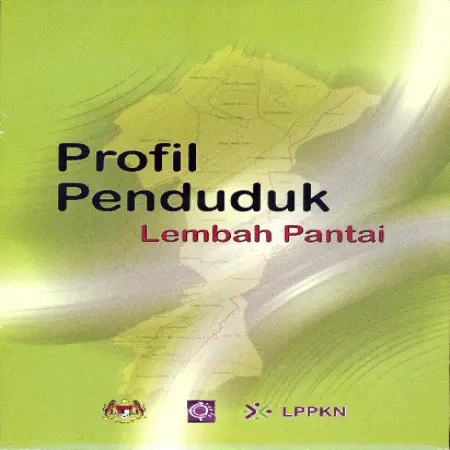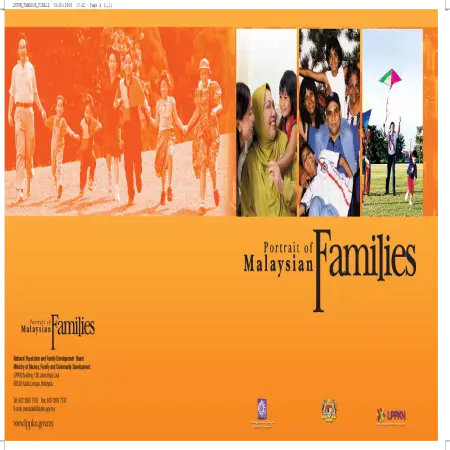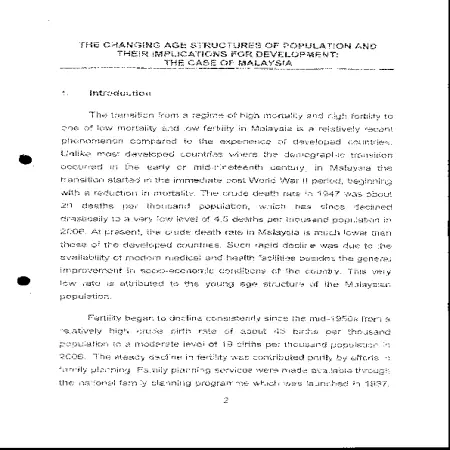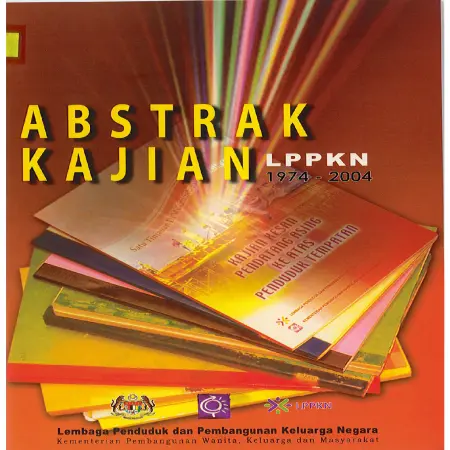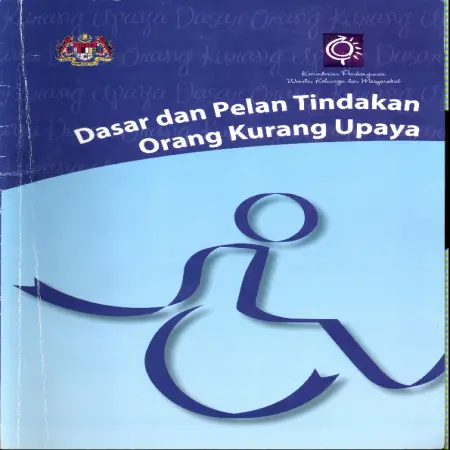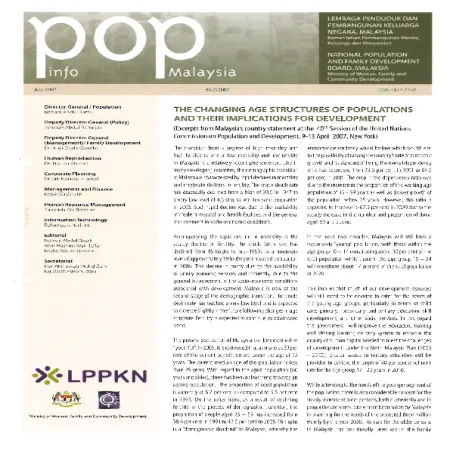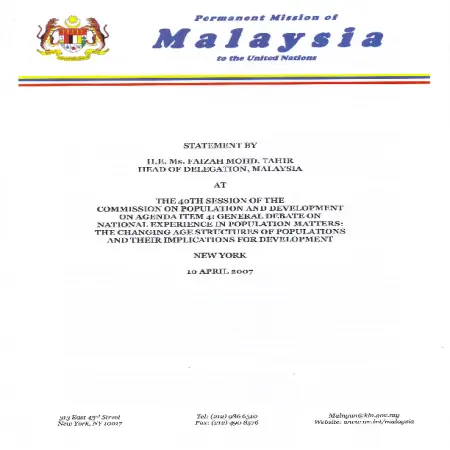Advanced Search
|
|
The 41st session of the Commission on Population and Development on item 4 : Population distribution, urbanisation, internal migration and development
Item Type: Country Statement
Editor:
Year: 08/04/2008
Abstract: Malaysia is currently experiencing an increase in population mobility mainly caused by industrialization and urbanization. Between 1970 and 2006, the proportion of population living in big cities (namely Kuala Lumpur, Penang and Johor Bahru) had doubled due to rapid urbanization mainly contributed by internal migration. Internal migration in Malaysia is gender, age and area selective, it is dominated by males mainly in the age group of 15 to 34 years, though female migration is expected to increase in the future.
|
|
|
|
|
|
Population ageing
Item Type: Newsletter
Editor:
Year: 00/01/2008
Abstract: According to United Nation’s estimates, 21 percent of the population in the developed countries was aged 60 years or over in 2005. This proportion is projected to increase to 28 percent in 2025 and 32 per cent in 2050. In countries where economies are in transition, the average proportion of the population aged 60 years or over was estimated at only 8 percent in 2005 but is expected to reach 13 percent by 2025 and nearly 20 percent by 2050. Thus, the number of older persons in the developing countries will likely more than double between 2005 and 2025. This increase is much larger than in the developed countries compared to countries where the economies are in transition, where the number of older persons will grow by about 44 percent and 32 percent respectively during the same period.
|
|
|
|
|
|
Profil penduduk Lembah Pantai
Item Type: Book
Editor:
Year: 00/00/2008
Abstract: A book that contains information on the residents and development of the residents of Lembah Pantai which is very suitable as a basis for program planning for the well -being of the people in this area. The Coastal Valley constituency is one of 222 Parliamentary constituencies. This division is located under the Federal Territory of Kuala Lumpur and has 14 areas within it. The areas consist of Bangsar Baru, Bukit Kerinchi, Jalan Maarof, Jalan Pantai Baru, Jalan Travers, Jalan Tun Sambanthan, Jalan Bukit Bangsar, Jalan Abdullah Hukum, Kg Sentosa, kg. Bohol, Pantai Dalam, Petaling Jaya, Taman Lucky and University of Malaya. The area of the Coastal Valley is 21.4 square kilometers.
|
|
|
|
|
|
The changing age structures of population and their implications for development: the case of Malaysia
Item Type: Conference or Workshop Item
Editor:
Year: 00/00/2008
Abstract: The transition from a regime of high mortality and high fertility to one of low mortality and low fertility in Malaysia is a relative recent phenomenon compared to the experience of developed countries. Unlike most developed countries where the demographic transition occurred in the early or mid-nineteenth century, in Malaysia the transition started in the immediate post World War II period, beginning with a reduction in mortality. The crude death rate in 1947 was about 20 deaths per thousand population, which has since declined drastically to a very low level of 4.5 deaths per thousand population in 2006. At present, the crude death rate in Malaysia is much lower than those of the developed countries. Such rapid decline was due to the availability of modern medical and health facilities besides the general improvement in socio-economic conditions of the country. This very low rate is attributed to the young age structure of the Malaysian population.
|
|
|
|
|
|
Dasar dan Pelan Tindakan Orang Kurang Upaya
Item Type: Act & Policy
Editor:
Year: 21/11/2007
Abstract: People with Disabilities (PWD) policy is based on the concept of equality of rights and opportunities for PWD to participate fully in society. This policy also emphasizes on human rights values such as integrity, honour and independence that will enable them to live independently.
|
|
|
|
|
|
The changing age structures of populations and their implications for development
Item Type: Newsletter
Editor:
Year: 00/07/2007
Abstract: The demographic transition in Malaysia is characterized by rapid declines in mortality and moderate declines in fertility. Rapid decline in mortality was due to the availability of modern medical and health facilities and the general improvement in socio-economic condition. While, steady decline in fertility due to the availability of family planning services and indirectly, due to the general improvement in the socio-economic conditions associated with development.
|
|
|
|
|
|
The 40th session of the Commission on Population and Development on agenda item 4: general debate on national experience in population matters: the changing age structures of populations and their implications for development, New York, 10 April 2007
Item Type: Country Statement
Editor:
Year: 10/04/2007
Abstract: The transition from a regime of high mortality and high fertility to one of low mortality and low fertility in Malaysia is a relatively recent phenomenon. similar to the trends in many developing countries, the demographic transition in Malaysia is characterized by rapid declined in mortality and moderate declines in fertility. The crude death rate has drastically declines from a high of 20.0 in 1947 to a very low level of 4.5 deaths per thousand populations in 2006. Such a rapid declines was due to improvements in the health sectors and higher socio-economic development in the country.
|
|
|
|







